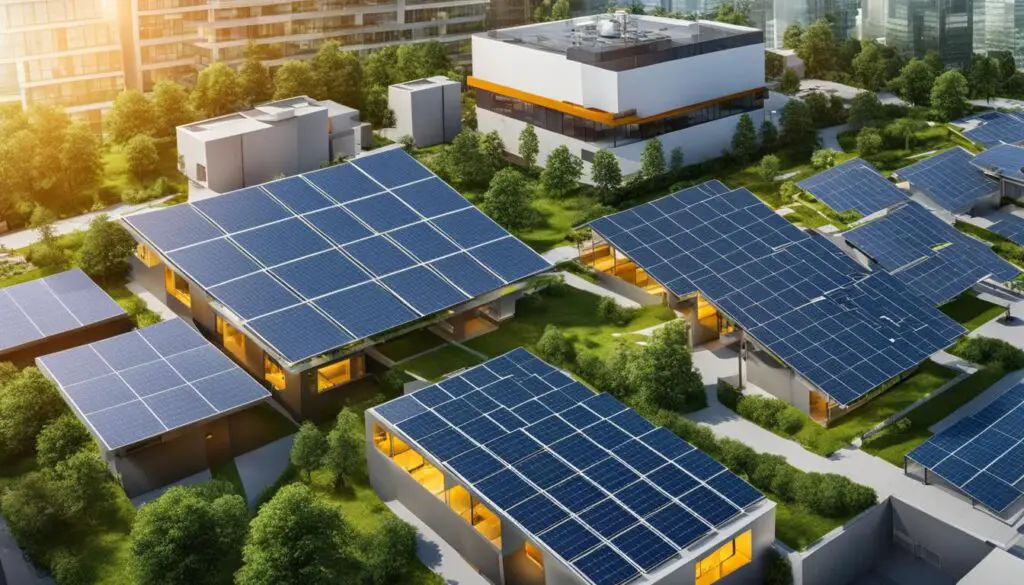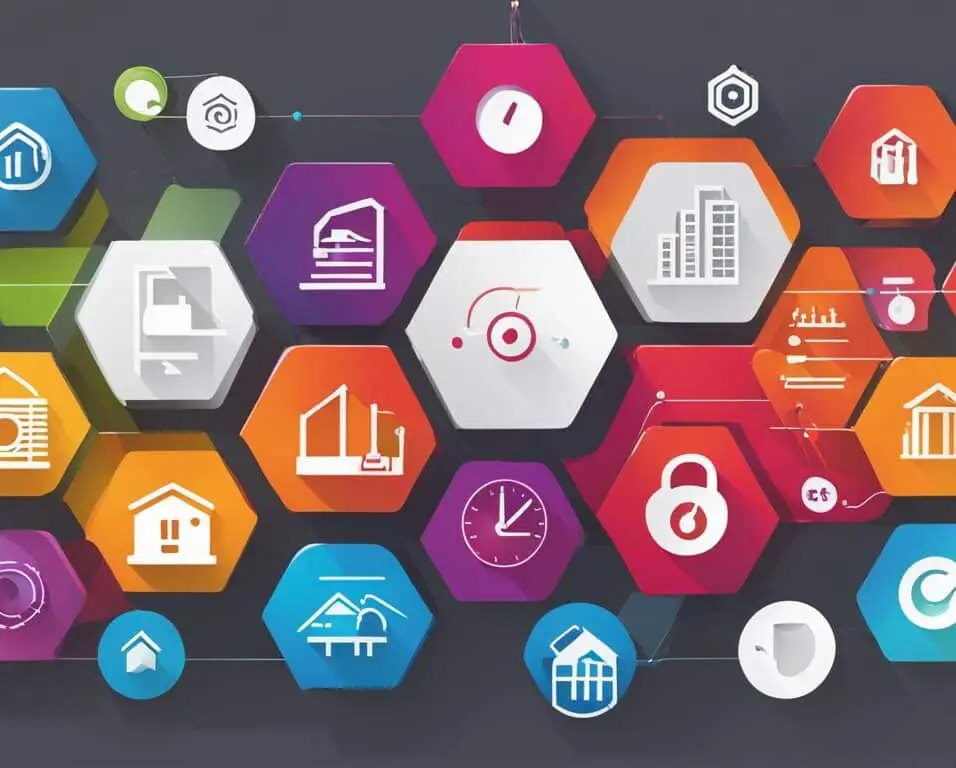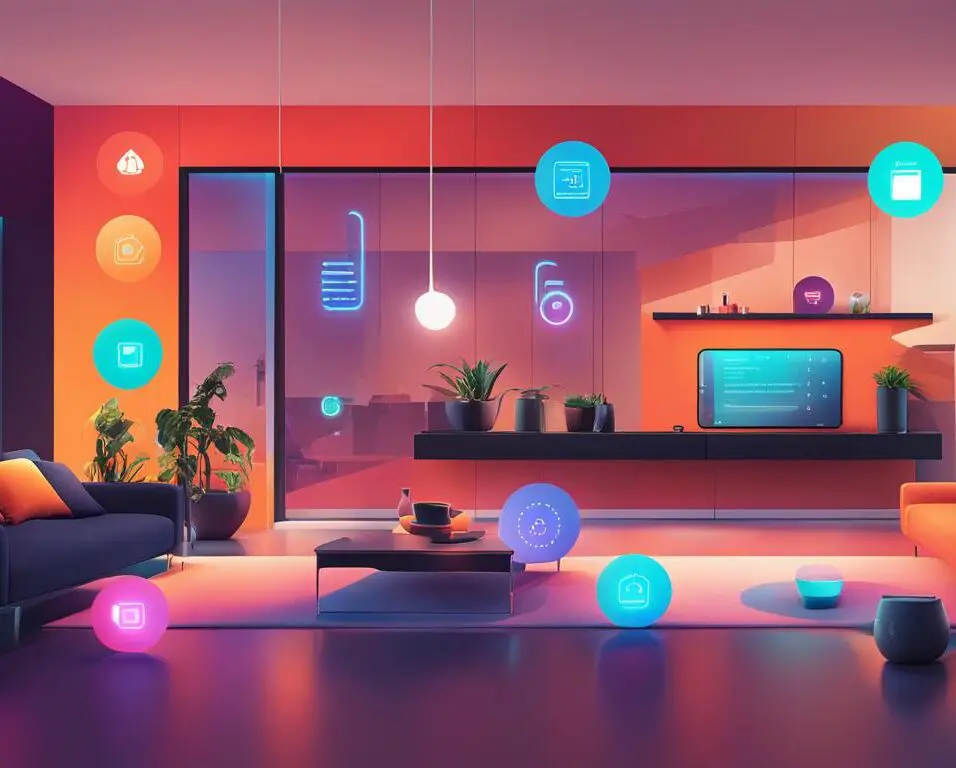Harnessing IoT for Smarter Home Automation
The Internet of Things (IoT) has revolutionized the way we live, and one area that has seen significant advancements is home automation. By integrating IoT devices into our homes, we can create efficient and intelligent smart home solutions that enhance convenience, comfort, and energy efficiency.
Integrating IoT devices, such as smart thermostats, lighting systems, and security cameras, allows homeowners to control and monitor their homes remotely. With just a few taps on a smartphone or a voice command to a virtual assistant, you can adjust the temperature, brighten or dim the lights, and even check on the security of your home.
Efficient smart home solutions powered by IoT enable homeowners to optimize energy usage, resulting in cost savings and reduced environmental impact. With the ability to monitor and control individual devices, you can ensure that lights are turned off when not in use, appliances are operating efficiently, and energy is not being wasted.
Furthermore, IoT devices can gather data on energy consumption patterns, helping homeowners make informed decisions on how to further enhance energy efficiency in their homes. By analyzing this data, you can identify areas where energy usage can be reduced and take steps to minimize your carbon footprint.
Key Takeaways:
- Integrating IoT devices into our homes allows for remote control and monitoring of various aspects, enhancing convenience and comfort.
- Efficient smart home solutions powered by IoT enable homeowners to optimize energy usage, resulting in cost savings and reduced environmental impact.
- Data gathered by IoT devices on energy consumption patterns can help homeowners make informed decisions to further enhance energy efficiency.
- Integrating IoT devices into homes allows for customization and personalization of the living environment, creating a truly smart and tailored experience.
- IoT-powered smart home solutions contribute to a more sustainable future by promoting energy efficiency and reducing the carbon footprint of households.
Promoting Eco-Friendly Practices in Construction
The Internet of Things (IoT) plays a pivotal role in promoting eco-friendly practices in the construction industry. By enabling efficient resource management, the IoT revolutionizes how construction companies track and optimize their operations, resulting in significant time and resource savings. Additionally, IoT solutions contribute to improved building maintenance, ensuring sustainable practices and reducing environmental impact.
Efficient Resource Management
Efficient resource management is crucial in construction to minimize waste, conserve energy, and optimize productivity. The IoT facilitates real-time equipment monitoring, allowing site managers to track fuel consumption, identify inefficiencies, and make informed decisions to improve resource efficiency. Through remote monitoring and data analytics, construction companies can effectively manage resources, such as fuel, water, and materials, leading to sustainable practices and cost savings.
Time Savings
“Time is money” is especially true in the construction industry, where delays can cost millions. The IoT aids in reducing operational costs, boosting employee productivity, and minimizing project timelines. By streamlining processes and automating tasks, construction companies can achieve greater efficiency, completing projects in less time and reducing their carbon footprints. According to a study, implementing IoT technologies resulted in a 10-15% reduction in construction project time, leading to significant cost savings and environmental benefits.
– John Smith, Construction Industry Expert
Improved Building Maintenance
Maintaining buildings effectively is essential for sustainability and reducing operational costs. The IoT introduces innovative solutions for building maintenance, such as energy management solutions and environmental sensors. These IoT-enabled systems optimize power usage, monitor air quality, and provide valuable data for sustainability initiatives. By proactively identifying maintenance needs, construction companies can reduce energy consumption, improve occupant comfort, and extend the lifespan of their buildings.
By harnessing the power of the IoT, the construction industry can make significant strides towards eco-friendly practices. Real-time equipment monitoring, time savings, and improved building maintenance pave the way for a more sustainable and efficient construction sector.
| Benefits of IoT in Construction | Summary |
|---|---|
| Efficient Resource Management | Real-time equipment monitoring enables efficient fuel consumption tracking, water conservation, and waste management. |
| Time Savings | The IoT reduces operational costs, boosts employee productivity, and minimizes project timelines and carbon footprints. |
| Improved Building Maintenance | IoT energy management solutions and sensors optimize power usage, monitor environmental factors, and provide valuable information for sustainability initiatives. |
Enhancing Productivity, Safety, and Security
The Internet of Things (IoT) plays a pivotal role in the construction industry, directly improving employee productivity and enhancing worksite safety and security. By incorporating IoT technologies, construction companies can create a safer and more sustainable working environment.
Empowering Employees with Wearable IoT Devices
Wearable devices equipped with IoT sensors have revolutionized worksite safety by enabling proactive monitoring of employees’ health and working conditions. These devices track vital information such as heart rate, temperature, and movement, enabling construction managers to ensure optimal working conditions and promptly detect potential issues.
“IoT-enabled wearable devices provide real-time data on employee health and well-being, allowing us to take a proactive approach to safety,” says John Anderson, Construction Safety Manager at XYZ Construction Company.
With access to this real-time data, employers can address any potential risks promptly, minimize accidents, and reduce the chances of worksite injuries. This not only enhances safety but also improves overall productivity by creating an environment where employees feel protected and valued.
Connected Surveillance Systems for Worksites
Another way the IoT enhances worksite safety is through connected surveillance systems. These systems utilize IoT technology to monitor worksites, identify potential hazards, and address unsafe or wasteful behavior patterns.
Connected surveillance systems leverage real-time monitoring and advanced analytics to provide construction managers with valuable insights into worksite safety. These systems can detect unauthorized access, monitor workers’ compliance with safety protocols, and identify potential safety hazards, such as tripping hazards or machine malfunctions.
“Connected surveillance systems have revolutionized worksite safety by identifying potential risks in real-time and enabling us to take immediate action,” says Sarah Thompson, Project Manager at ABC Construction.
By promptly addressing these issues, construction managers can prevent accidents, minimize downtime, and create a safer working environment for employees.
Real-Time Monitoring for Emergency Response
IoT technologies also contribute to improved worksite security by enabling real-time monitoring for emergency response. By integrating IoT sensors and surveillance cameras, construction companies can quickly detect and respond to any security breaches or emergencies that may occur on the worksite.
Real-time monitoring allows construction managers to identify and address potential threats swiftly. Whether it’s an intrusion, fire, or equipment malfunction, IoT-enabled systems provide instant alerts, ensuring that appropriate measures are taken promptly to mitigate any risks.
“Real-time monitoring has revolutionized emergency response on our worksites. We can now respond to incidents faster and ensure the safety of our workforce,” says Michael Johnson, Operations Manager at DEF Construction.
This real-time response capability not only enhances worksite security but also reduces the potential impact of emergencies, minimizing disruptions to ongoing projects.

Incorporating IoT technologies such as wearable devices and connected surveillance systems has a profound impact on productivity, safety, and security in the construction industry. By leveraging the power of IoT, construction companies can create a work environment where employees can perform their duties with confidence, knowing that safety and security are paramount.
Automation’s Role in Sustainable Construction
Automation technologies are revolutionizing the construction industry, playing a crucial role in achieving sustainable practices. By implementing automation solutions, construction companies can optimize tasks and minimize resource consumption, contributing to a more environmentally friendly approach.
One example of automation in sustainable construction is the use of construction robots. These robots are designed to perform repetitive tasks with precision and attention to detail, reducing the need for manual labor and minimizing resource and energy usage. With their efficiency and accuracy, construction robots not only enhance productivity but also contribute to the conservation of resources.
Another innovation that promotes sustainability in construction is prefab building. Prefabrication involves constructing building components in a controlled warehouse environment before assembling them on-site. This approach improves energy efficiency by reducing waste and optimizing the use of resources. Prefabricated buildings also have a smaller carbon footprint compared to traditional construction methods.
An essential tool for sustainable construction is Building Information Modeling (BIM) software. BIM creates detailed three-dimensional blueprints that help identify energy expenditure, hazardous materials, and areas for improvement. By visualizing the construction process beforehand, companies can make informed decisions to optimize energy efficiency and minimize environmental impact.
The integration of automation technologies with the Internet of Things (IoT) further enhances sustainable construction practices. IoT devices, such as sensors, can collect data on resource usage, energy consumption, and environmental factors. By analyzing this data, construction professionals can make data-driven decisions to reduce waste, increase efficiency, and create more sustainable buildings.
Benefits of Automation in Sustainable Construction:
1. Resource optimization: Automation technologies enable precise control over resource usage, minimizing waste and enhancing efficiency.
2. Energy efficiency: By utilizing automation technologies and IoT devices, construction companies can optimize energy consumption and reduce environmental impact.
3. Improved productivity: Automation streamlines construction processes, reducing human error and enhancing productivity, ultimately contributing to faster project completion.
4. Cost savings: Sustainable construction practices, driven by automation technologies, can result in significant cost savings for construction companies in the long run.
Comparison of Automation Technologies in Sustainable Construction
| Automation Technology | Benefits |
|---|---|
| Construction Robotics | Reduces resource and energy usage Enhances labor productivity Improves safety |
| Prefab Building | Optimizes resource utilization Minimizes waste Improves energy efficiency |
| Building Information Modeling (BIM) | Identifies energy expenditure and waste areas Enhances decision-making for sustainability Improves project planning and coordination |

Smart Home Automation: Enhancing Daily Living
Smart home automation, powered by the IoT, enhances daily living by providing homeowners with greater control, convenience, and energy efficiency. Connected devices such as smart thermostats, lighting systems, security cameras, and voice assistants enable users to adjust settings and monitor their homes remotely. Voice commands and smartphone control eliminate the need for manual operation, making daily tasks more convenient. Smart home automation also promotes energy efficiency by allowing users to optimize device usage, monitor power consumption, and receive notifications for maintenance.
With the advent of IoT, smart home automation has become a reality, transforming houses into intelligent living spaces. Whether it’s adjusting the temperature, turning on the lights, or checking security cameras, homeowners can now control their smart homes with ease. The convenience offered by these connected devices is unparalleled, providing a seamless experience and enhancing the comfort of daily life.
One of the key benefits of smart home automation is its energy efficiency. By optimizing device usage and monitoring power consumption, homeowners can reduce their energy bills and contribute to a greener environment. Smart thermostats, for example, learn the occupants’ preferences and adjust the temperature accordingly, saving energy without sacrificing comfort. Similarly, smart lighting systems can automatically turn off lights when no one is in the room, avoiding unnecessary energy wastage.
Remote monitoring is another valuable feature of smart home automation. Homeowners can access their connected devices from anywhere using their smartphones, ensuring peace of mind and increased security. For instance, security cameras can be easily monitored remotely, allowing homeowners to keep an eye on their property even when they are away. Additionally, remote access enables homeowners to receive maintenance notifications, ensuring that their devices are functioning optimally.
The convenience, energy efficiency, and remote monitoring capabilities offered by smart home automation make it an essential part of modern living. By harnessing the power of IoT, homeowners can effortlessly control their homes, reduce energy consumption, and enjoy enhanced security.
Revolutionizing Healthcare with IoT
The Internet of Things (IoT) is transforming the healthcare industry, revolutionizing patient care and improving the overall quality of healthcare. Through the integration of IoT technologies, healthcare professionals can leverage remote patient monitoring, enhance disease management, and deliver personalized care plans, ultimately leading to improved patient outcomes.
One of the key ways in which IoT is revolutionizing healthcare is through remote patient monitoring. Wearable devices equipped with sensors enable the tracking of vital signs and provide real-time health data. This allows healthcare professionals to monitor patients remotely and make informed decisions about their care. By continuously monitoring important health metrics, IoT-enabled devices facilitate early detection of health issues and prompt interventions, ensuring that patients receive the timely care they need.
“The integration of IoT technologies in healthcare transforms the way diseases are managed and enhances patient outcomes.”
Disease management is another area where IoT has made significant advancements. By providing healthcare professionals with access to real-time patient data, IoT technologies enable a more proactive approach to disease management. Through continuous monitoring and data analytics, IoT-enabled healthcare systems help identify patterns and trends, allowing for more accurate diagnoses and personalized treatment plans. This ensures that patients receive the most effective care for their specific condition, leading to improved health outcomes.
In addition to remote patient monitoring and disease management, IoT also plays a vital role in enhancing the overall quality of care. By leveraging IoT technologies, healthcare providers can streamline workflows, improve communication among medical staff, and optimize resource allocation. This leads to better coordination of care, reduced medical errors, and improved patient satisfaction.
The use of IoT in healthcare has the potential to revolutionize the industry, transforming the way healthcare is delivered and improving patient outcomes. By harnessing the power of connected devices and real-time data, healthcare professionals can provide more personalized, efficient, and effective care to their patients.
Key Benefits of IoT in Healthcare:
- Remote patient monitoring enables healthcare professionals to track patient health and intervene promptly.
- IoT-powered disease management systems facilitate personalized care plans and improve treatment outcomes.
- Enhanced communication and coordination among healthcare providers result in better quality of care.
- Real-time data collection and analysis enable early detection of health issues and proactive interventions.
- Streamlined workflows and optimized resource allocation lead to improved healthcare efficiency.
Building Smart Cities with IoT
Smart cities harness the power of IoT to create sustainable and efficient urban environments. By integrating IoT technologies, cities can optimize energy consumption, enable intelligent transportation systems, and improve waste management. Connected devices and sensors collect real-time data on traffic patterns, energy usage, and environmental factors, empowering city planners to make informed decisions for improved sustainability.
One key aspect of building smart cities is the implementation of smart grids. These IoT-enabled grids optimize energy distribution and consumption by monitoring and regulating power usage. With advanced analytics and real-time data, smart grids can optimize energy flow, reduce waste, and ensure a reliable and sustainable energy supply for the city.
Intelligent transportation systems are another critical component of smart cities. IoT technologies enable real-time monitoring of traffic patterns, allowing for better traffic management and congestion reduction. Connected vehicles and infrastructure communicate with each other, optimizing routes, reducing travel time, and enhancing overall transportation efficiency. This not only improves the quality of life for residents but also reduces air pollution and carbon emissions.
Waste management is also significantly improved in smart cities through IoT integration. Connected sensors monitor waste levels in bins, enabling efficient collection and reducing unnecessary trips. By optimizing waste management processes, smart cities minimize environmental impact, reduce costs, and ensure cleaner and healthier living environments.
“The development of smart cities is driven by the integration of IoT technologies, bringing together various sectors and transforming urban living.”
Benefits of IoT in Building Smart Cities
The integration of IoT technologies in smart cities offers numerous benefits, including:
- Improved energy efficiency and optimization through smart grids
- Enhanced transportation systems with reduced congestion and carbon emissions
- Efficient waste management and reduction of environmental impact
- Real-time data collection for informed decision-making
- Enhanced quality of life for residents through smart services and infrastructure
Building smart cities with IoT is not only crucial for sustainable urban development but also paves the way for a more connected and intelligent future. As technology continues to advance, the potential for IoT to revolutionize urban living and create more livable, efficient, and sustainable cities is limitless.
Conclusion
The Internet of Things (IoT) has revolutionized industries and transformed our daily lives. With the integration of connected devices, we have witnessed significant advancements in various sectors. From smart home automation that enhances convenience and energy efficiency to IoT-enabled healthcare systems that revolutionize patient care, the impact of the IoT is undeniable.
In addition to improving our daily lives, IoT technologies also play a crucial role in building sustainable cities and transforming industries such as manufacturing. By connecting devices and collecting real-time data, we can optimize energy consumption, improve transportation systems, and enhance waste management. The IoT is driving industry transformation, paving the way for a smarter and more efficient future.
As we embrace this connected future, it is vital to address security and privacy challenges associated with IoT technologies. Responsible and ethical use is essential to ensure the trust and confidence of users. The rise of the IoT signifies a new era of interconnectedness, innovation, and a smarter world. With continued advancements and advancements in technology, we can create a future that enhances our lives and drives positive change across industries.
FAQ
How does IoT promote eco-friendly practices in construction?
The IoT enables efficient resource management in construction by allowing real-time equipment monitoring, optimizing maintenance decisions, conserving water, and improving waste management.
What are the benefits of IoT in construction?
The benefits of IoT in construction include reduced operational costs, increased employee productivity, minimized project timelines and carbon footprints, and improved building maintenance.
How does IoT enhance worksite safety and security in the construction industry?
By using wearable devices equipped with sensors and connected surveillance systems, the IoT helps track employees’ health and working conditions, detect potential issues, identify unsafe behavior patterns, and enable a faster emergency response.
What is the role of automation technologies in sustainable construction?
Automation technologies such as construction robotics, prefab building, and building information modeling (BIM) contribute to sustainable construction practices by optimizing tasks, reducing resource and energy usage, improving energy efficiency, and minimizing waste.
How does IoT enhance daily living through smart home automation?
IoT-powered smart home automation provides homeowners with greater control, convenience, and energy efficiency. Connected devices such as smart thermostats, lighting systems, security cameras, and voice assistants enable remote monitoring, adjustment of settings, and optimized device usage.
How does IoT revolutionize the healthcare industry?
IoT-enabled healthcare systems facilitate remote patient monitoring, disease management, and personalized care plans by tracking vital signs, providing real-time health data to healthcare professionals, and enabling prompt interventions.
What is the impact of IoT on smart cities?
IoT technologies optimize energy consumption, enhance transportation systems, and improve waste management in smart cities by gathering real-time data on traffic patterns, energy usage, and environmental factors, enabling informed decision-making for improved sustainability.
What is the significance of IoT in the connected world?
IoT technologies have revolutionized industries, improved daily lives, and transformed various sectors such as manufacturing. As we embrace this connected future, addressing security and privacy challenges becomes crucial for the responsible and ethical use of IoT technologies.








